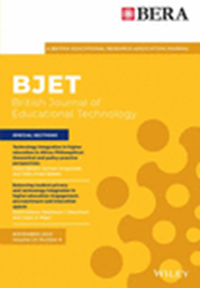Investigating the impact of AR technologies on geometric learning in primary school: A comparison between marker-based and markerless AR
Abstract
Over the past decade, augmented reality (AR) has gained traction in geometric learning for its pedagogical potential. However, research on how learners engage with different AR technologies and when and how to incorporate them has remained largely unexplored. Employing a learning analytics approach, this study investigates the impact of marker-based and markerless AR technologies on geometric learning and student engagement in primary school classrooms. We developed a mobile AR application that integrates both marker-based (ie, using predefined visual markers to trigger content) and markerless (ie, triggering content without predefined markers) AR modes for learning 3D shapes and conducted a quasi-experimental study with 43 sixth-grade students. To comprehensively capture student engagement, we collected pre- and posttests on geometric understanding, along with in-app log and device sensor data. Our findings showed that both AR technologies effectively enhance geometric understanding. However, engagement patterns varied significantly; marker-based AR led to more focused cognitive tasks, while markerless AR facilitated dynamic spatial navigation. The study highlights the distinct technical affordances of each AR technology that can lead to unique pedagogical advantages. Based on these findings, we propose a hybrid AR model for geometric learning that leverages the strengths of both marker-based and markerless AR.
Practitioner notes
What is already known about this topic
- Augmented reality (AR) is a powerful tool for enhancing geometric learning by providing immersive and interactive learning experiences.
- Marker-based AR—using predefined visual markers (eg, QR codes or images) to trigger content—has been widely used in education with its ease of use and setup.
- Markerless AR—using spatial recognition capabilities without predefined visual markers—has recently emerged as a new and accessible technology, offering the potential for more dynamic and immersive learning experiences in classroom settings.
What this paper adds
- Past studies have predominantly focused on answering whether marker-based AR can be effectively used compared with traditional tools (eg, computers); this paper addresses how and when different AR technologies can be used.
- Findings show that both marker-based and markerless AR technologies enhance geometric understanding but lead to different engagement patterns in students.
- Marker-based AR promotes more focused cognitive tasks, whereas markerless AR encourages more dynamic spatial navigation and interaction with the learning environment.
Implications for practice and/or policy
- Leveraging learning analytics can provide deeper insights into how students engage with digital technologies.
- Educators should consider the distinct technical affordances of AR technologies when designing their instruction.
- Implementing a hybrid AR model that leverages both marker-based and markerless AR can optimize learning outcomes in geometric education.


 求助内容:
求助内容: 应助结果提醒方式:
应助结果提醒方式:


